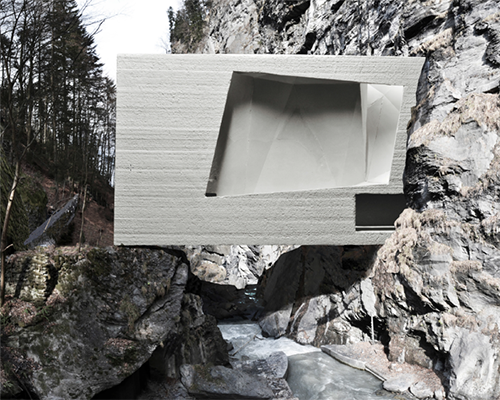| Carmela Huwyler, Mathaeus Nierzwicki |
Design Exploration
For the FS2015 the emphasis has been put
on the design operation of carving and the solid-void duality. The course also offered short tutorials to equip the students with
basic skills for the elaboration of physical and digital models. Following the theoretical and practical inputs, the students,
organized in groups, have been asked to develop a design exploration at the building scale. The design exploration has been
undertaken by the students following four main steps, working at the same time with digital and physical models.
In Step 1 (Spatial Articulation), the students, organized in teams of two, chose four programmatic activities (2 on summer and 2 on
winter) and, based on them, produce four spatial voids, which represent the spaces were the activities take place. After dimensioning
the spatial voids according to proportion criteria, the students developed a concept to articulate them in space, following specific
connection logics (internal circulation, visual interdependency, activities interaction). Then, they generated a solid mass that
contains the spatial voids in the form of a bounding box and using Boolean operations, they subtracted the spatial voids (positive)
from the solid mass in order to produce a hollowed solid (negative), and as such a stereotomic model (positive+negative).
In Step 2 (Static Stability), the students tested the structural behaviour of their hollowed solid. After defining the position of 3
supports and locating the centre of mass of the system, the students tested the consequences of removing mass from their hollowed
solid or modifying the position of the supports on the overall static stability of the system under self-weight.
In Step 3 (Adaptation to Context), given a specific site in a natural context allocated in Bad Ragaz (Kanton St. Gallen), the
students worked with the operations introduced in the previous steps to fully develop their design exploration. They were allowed to
remove mass from the hollowed solid in order to incorporate inputs such as access, circulation and views according to the given
context. Moreover, they modified their hollowed solid by removing internal mass in order to incorporate servant spaces like services
and internal circulation.
In Step 4 (Spatial Qualities), the students focused in the aesthetical aspects of the project. Particularly relevant in the
exploration was the treatment and incorporation of light addressing questions related both with the structural expression and the
spatial qualities of their building.
Teaching Team
Juan José Castellón, Pierluigi D′Acunto, Alessandro Tellini, Prof. Dr. Joseph Schwartz
Invited Guest
Jeannette Kuo (Karamuk Kuo)
Students
Yu Ma, Chunhui Liu, Xijie Ma, Yunhan Lin, Sarah Barras, Samuel Klingele, Carmela Huwyler, Mathäus Nierzwicki, Viktoriya Maleva, Burak
Düvenci, Marc Antoine Lallemand
last modified 28.10.2018
